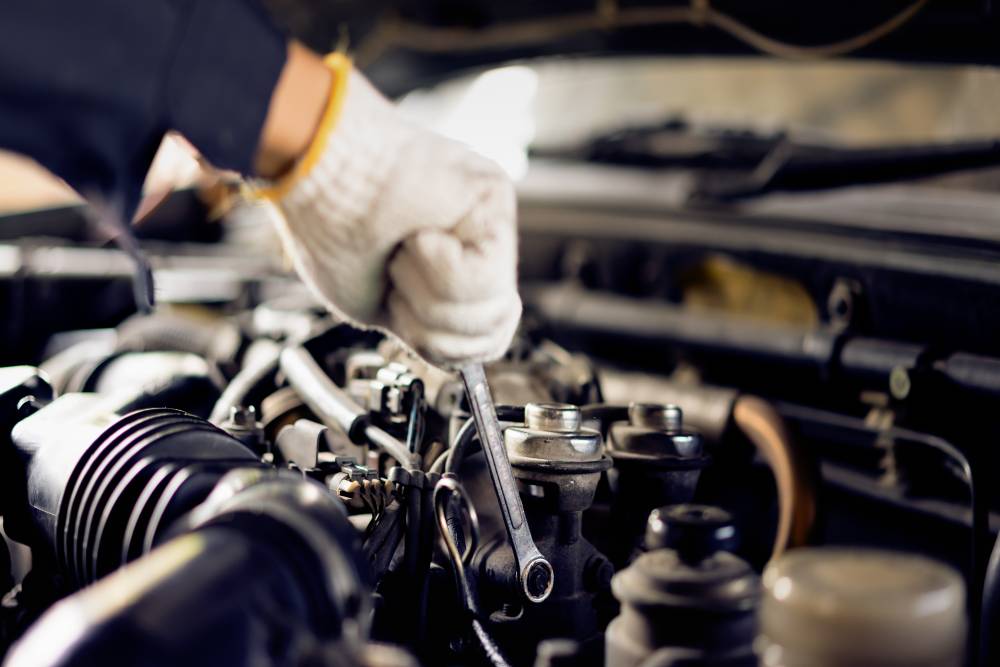With the 1970 passage of the Clean Air Act, and new attention being paid to the pollutants being emitted by cars and trucks, many states began requiring that every car on the road pass an emissions test prior to the renewal of the registration.
In some states, the tests are annual, others require it every other year. Some states don’t begin testing vehicles until after they reach a certain age.
These diagnostic reviews test the emissions from cars of exhaust gases that exit the tailpipe. Some states also require an onboard diagnostic test for vehicles built after 1995, which uses a computer to take readings from the car’s systems.
What Is an Emissions Test?
The emissions test involves inserting an exhaust gas analyzer into the car’s tailpipe while it is running and analyzing the gases it emits. The test is measuring the amount of hydrocarbon gas, carbon monoxide, carbon dioxide and often nitrous oxides exiting the exhaust system and polluting the air.
The onboard diagnostic test plugs into the vehicle’s onboard computer and takes readings to determine whether the car is operating cleanly.
These tests often also involve a visual inspection by the certified technician as well. He or she is checking the gas cap, tailpipe and emissions equipment to make sure they are in good physical condition.
In most states, you must pay to have the emissions test and take your car to an emissions testing center – often a certified service station – to undergo the test. The expense and inconvenience are good reasons to try to pass the car emissions test on the first try.
Why Some Cars Fail Emissions Tests
Before we discuss the tips and tricks to passing an emissions test – whether it is a tailpipe test (also called a smog test) or an onboard diagnostic scan – it is worth reviewing the issues that cause a vehicle to fail. Avoiding these helps guide the decisions required to pass the test.
- Emissions equipment missing or not working. Your vehicle has a host of parts designed to clean the exhaust before it exits the tailpipe. The best-known of these is the catalytic converter. If the catalytic converter, or any other part of the emissions system fails to convert the toxic gases produced by the engine into less harmful byproducts, too much pollutant will exit the exhaust pipe and trigger failure of the test.
- Faulty evaporative emissions control system. Several parts comprise this system, including the vapor canister and the gas cap. When they malfunction, gasoline vapor will exit the gas tank, leaky hoses or vents.
- The “Check Engine” light is illuminated. This automatically leads to a failed emissions test. Why should the technician bother determining whether your vehicle is running properly when the dashboard says it isn’t?
- An imbalance in the air/fuel mixture. For smooth operation of the vehicle, the exact proportions of air and fuel must combine in the combustion chamber to be ignited, powering the pistons and turning the wheels. Too rich a mixture – often due to malfunctioning injectors or a faulty oxygen sensor – will result in excess fuel coming out of the tailpipe.
- Engine misfiring. When the ignition system fails to work correctly, the air/fuel mixture does not get burned properly, leading to the same problem.
- Computer problems. Modules in your car can go haywire, just as they can in your tablet or desktop, and direct the vehicle’s other systems to malfunction. Any issues with the electronics, wiring or network in the computer can raise red flags on the emissions test.
How to Pass the Car Emissions Test
Knowing all that, let’s take a look at the steps you can take to avoid these problems and pass your emissions test on the first attempt.
- Bring the vehicle in for regular service. The best way to ensure your car passes an emissions test is to take care of it as recommended in the owner’s manual. Proper maintenance avoids many of the issues below. That includes fluid changes, filter replacements and hose and belt inspections.
- Attend to the “Check Engine” light. Unless the light itself is malfunctioning, “Check Engine” lights illuminate for a reason. Hunt down the reason and address it. Otherwise, automatic failure. One of the most common reasons is a failed oxygen sensor, which regulates the air/fuel mixture. Replacing that is inexpensive and easy, and will save you expensive issues down the road with the catalytic converter.
- Warm up your engine. Bringing a car in cold to the emissions testing center is a prescription for failure. It is important to drive the car for 20 minutes on the highway before getting tested. Driving at highway speeds allows the catalytic converter to heat up and burn out any oil and gas residue.
- Clean out the fuel system. A clogged fuel system, whether at the fuel injector nozzles, in the cylinders, fuel lines or hoses, or at the fittings and joints, allows unburned gas to circulate through the engine and out the exhaust pipe. Add a bottle of BlueDevil Complete Fuel System Cleaner to your gas tank to remove fuel deposits.
- Change your oil. Dirty oil isn’t a direct cause of a failed emissions test, but it inhibits the proper functioning of the engine and can lead secondarily to problems that show up in the emissions test. Plus, changing oil on a regular schedule is the single most important thing an owner can do to extend the life of their vehicle.
- Tune it up. If the vehicle hasn’t had a tune-up recently, this would be a good time. During tune-ups, mechanics inspect many of the elements that lead to emissions test failures, like fluid levels, hoses and filters. A mechanic is also more likely than most owners to uncover issues with gas caps, tailpipes and so on. Just make sure to drive the car around for a while after the tune-up in case its computer was reset during the service.
- Inspect your gas cap. You probably don’t pay much attention to this item, but a damaged or badly fitting gas cap can cause gas to leak and set off emissions test alarms.
- Inflate your tires. What? Yes, many emissions tests involve a dynamometer test, which involves placing the tires on rollers to allow the engine to run at high speeds without the vehicle moving. Under-inflated tires will make the engine work harder and put the car at risk of failing the test.
- Give your monitors time to monitor. This one is a bit technical, so stay with us. The onboard computer is constantly monitoring various vehicle systems, including the emissions systems. During the onboard diagnostic test, the diagnostic computer will scan your vehicle computer’s data for information on your car’s performance. Whenever the battery is disconnected – for example, during a tune-up – the onboard computer resets, erasing all the data. If there is no data for the computer to scan during an emissions test, the state will assume that the computer is not monitoring the car’s performance and flunk you. What can you do? If anyone has disconnected the battery recently, drive the car around as much as possible, both in city and highway conditions, prior to the test. Aim for two weeks of driving. That will allow the onboard monitors to gather the necessary information for the emissions test to determine your car is performing as it should be.
- Do a pre-test! In many states, service stations will conduct their own unofficial emissions tests for free. This benefits them because if they find anything that might lead to a failed test, they have your car and can offer to fix it. It’s a win-win, since you would have to get the problem solved in any case, and you avoid failing the official emissions test.
If for any reason your old jalopy didn’t pass muster on the first go-round, take these steps and then get it tested at a service station before bringing it in for a second try. As they say in the emissions testing business: A pre-test beats a re-test.
BlueDevil Products can be found at AutoZone, Advance Auto Parts, O’Reilly Auto Parts, NAPA, Parts Authority, Auto Value, Bumper to Bumper and other major auto parts retailers.
BlueDevil Products can be found on Amazon.com or at AutoZone, Advance Auto Parts, O’Reilly Auto Parts, NAPA, and other major auto parts retailers.
4 responses to "10 Ways to Pass the Car Emissions Test"
4 Comments
Leave a Reply
Related Articles




I love these articles! They are so practicle.
Keeping your vehicle up on its maintenance program is the absolute best way to stay out of emissions trouble. Many of the contributing issues can be fixed by owners themselves using regular tools, parts from parts suppliers and you tube videos.
This article came at the perfect time for my 1988 Chevy c1500 that I have not driven for a long time… getting it ready for its smog test. Thanks for the wealth of info here and also for providing great customer service when calling to get my questions answered about the best product to use for certain situations.
In OBD2 , Does emission test read IM Readiness Since last were Cleared or IM for Current Drive Cycle ?